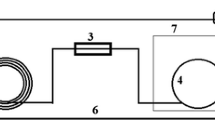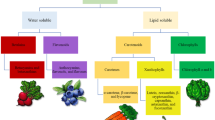Abstract
Trace-level analysis of cork off-flavor compounds considered as responsible for typical [2,4,6-trichloroanisole (TCA)] and atypical cork taint [geosmin (GSM); 2-methylisoborneol (MIB); 3-isopropyl-2-methoxypyrazine (IPMP); 3-isobutyl-2-methoxypyrazine (IBMP); 3,5-dimethyl-2-methoxypyrazine (MDMP)] was achieved for cork soaks and wines for concentrations below odor threshold (MIB only in cork soaks). The analytical approach was based on headspace solid-phase microextraction and heart-cut multidimensional gas chromatography with tandem mass spectrometric detection. Quantification was done using a stable isotope dilution assay. Individual cork stoppers with varying sensory off-odor descriptions were analyzed. In particular, IPMP and IBMP correlated with the cork stoppers described with green attributes. MDMP was found in samples described as dusty–musty or nutty-like. In a migration study, transport of off-flavor compounds from affected cork stoppers into the corresponding wine could be observed after a storage period of 13 months. Multivariate statistics on the wines’ sensory analysis and chemical data showed a good correlation of the individual off-flavor compound concentration, its sensory description and the off-flavor perceived in the wine.


Similar content being viewed by others
References
Buser HR, Zanier C, Tanner H (1982) Identification of 2,4,6-trichloroanisole as a potent compound causing cork taint in wine. J Agric Food Chem 30:359–362
Amon JM, Vandepeer JM, Simpson RF (1989) Compounds responsible for cork taint in wine. Aust NZ Wine Ind J 4:62–69
Simpson RF, Capone DL, Sefton MA (2004) Isolation and identification of 2-methoxy-3,5-dimethylpyrazine, a potent musty compound from wine corks. J Agric Food Chem 52:5425–5430
Prat C, Trias R, Cullere L, Escudero A, Antico E, Baneras L (2009) Off-odor compounds produced in cork by isolated bacteria and fungi: a gas chromatography-mass spectrometry and gas chromatography-olfactometry study. J Agric Food Chem 57:7473–7479
Simpson RF (1990) Cork taint in wine: a review of the causes. Aust NZ Wine Ind J 5:286–296
Chatonnet P, Guimberteau G, Dubourdieu D, Boidron J (1994) Nature et origine des odeurs de ‘moisi’dans les caves. Incidences sur la contamination des vins. J Int Sci Vigne Vin 28:131–151
Sefton MA, Simpson RF (2005) Compounds causing cork taint and the factors affecting their transfer from natural cork closures to wine—a review. Aus J Grape Wine Res 11:226–240
Slabizki P, Fischer C, Legrum C, Schmarr H-G (2015) Characterization of atypical off-flavor compounds in natural cork stoppers by multidimensional gas chromatographic techniques. J Agric Food Chem 63:7840–7848
Lovell RT, Broce D (1985) Cause of musty flavor in pond-cultured penaeid shrimp. Aquaculture 50:169–174
Watson SB, Brownlee B, Satchwill T, Hargesheimer EE (2000) Quantitative analysis of trace levels of geosmin and MIB in source and drinking water using headspace SPME. Water Res 34:2818–2828
Gerber NN, Lechevalier HA (1965) Geosmin, a earthy-smelling substance isolated from actinomycetes. Appl Microbiol 13:935–938
Dickschat JS, Martens T, Brinkhoff T, Simon M, Schulz S (2005) Volatiles released by a Streptomyces species isolated from the North Sea. Chem Biodiversity 2:837–865
Hsieh W-H, Hung W-N, Wang G-S, Hsieh S-T, Lin T-F (2012) Effect of pH on the analysis of 2-MIB and geosmin in water. Water Air Soil Pollut 223:715–721
Darriet P, Pons M, Lamy S, Dubourdieu D (2000) Identification and quantification of geosmin, an earthy odorant contaminating wines. J Agric Food Chem 48:4835–4838
Ventura F, Quintana J, Gomez M, Velo-Cid M (2010) Identification of alkyl-methoxypyrazines as the malodorous compounds in water supplies from northwest spain. Bull Environ Contam Toxicol 85:160–164
Mottram DS, Patterson RLS, Warrilow E (1984) 2,6-Dimethyl-3-methoxypyrazine: a microbiologically-produced compound with an obnoxious musty odor. Chem Ind (London):448–449
Chatonnet P, Fleury A, Boutou S (2010) Origin and incidence of 2-methoxy-3,5-dimethylpyrazine, a compound with a “fungal” and “corky” aroma found in cork stoppers and oak chips in contact with wines. J Agric Food Chem 58:12481–12490
Murray KE, Whitfield FB (1975) Occurrence of 3-alkyl-2-methoxypyrazines in raw vegetables. J Sci Food Agric 26:973–986
Lacey MJ, Allen MS, Harris RLN, Brown WV (1991) Methoxypyrazines in Sauvignon blanc grapes and wines. Am J Enol Viticult 42:103–108
Allen MS, Lacey MJ, Harris RLN, Brown WV (1991) Contribution of methoxypyrazines to Sauvignon blanc wine aroma. Am J Enol Viticult 42:109–112
Pickering G, Lin J, Riesen R, Reynolds A, Brindle I, Soleas G (2004) Influence of Harmonia axyridis on the sensory properties of white and red wine. Am J Enol Viticult 55:153–159
Allen MS, Lacey MJ, Boyd SJ (1995) Methoxypyrazines in red wines: occurrence of 2-methoxy-3-(1-methylethyl)pyrazine. J Agric Food Chem 43:769–772
Schmarr H-G, Sang W, Ganß S, Koschinski S, Meusinger R (2011) New insights into the synthesis and characterization of 2-methoxy-3-alkylpyrazines and their deuterated isotopologues. J Label Compd Radiopharm 54:438–440
Schmarr H-G, Koschinski S, Sang W, Slabizki P (2012) Trace level analysis of corky off-flavor compounds: development of a new analytical method based on solid phase extraction and analysis by multidimensional gas chromatography with mass spectrometric detection. J Chromatogr A 1226:96–102
Slabizki P, Legrum C, Meusinger R, Schmarr H-G (2014) Characterization and analysis of structural isomers of dimethyl methoxypyrazines in cork stoppers and ladybugs (Harmonia axyridis and Coccinella septempunctata). Anal Bioanal Chem 406:6429–6439
Legrum C, Slabizki P, Schmarr H-G (2015) Enantiodifferentiation of 3-sec-butyl-2-methoxypyrazine in different species using multidimensional and comprehensive two-dimensional gas chromatographic approaches. Anal Bioanal Chem 407:253–263
Schmarr H-G, Slabizki P, Legrum C (2013) Optimization in multidimensional gas chromatography applying quantitative analysis via a stable isotope dilution assay. Anal Bioanal Chem 405:6589–6593
DIN 32645 (2008) Chemische Analytik-Nachweis-, Erfassungs- und Bestimmungsgrenze unter Wiederholbedingungen-Begriffe, Verfahren. Auswertung, Beuth, Berlin
McCallum R, Pendleton P, Schumann R, Trinh MU (1998) Determination of geosmin and 2-methylisoborneol in water using solid-phase microextraction and gas chromatography-chemical ionisation/electron impact ionisation-ion-trap mass spectrometry. Analyst 123:2155–2160
Prat C, Baneras L, Antico E (2008) Screening of musty-earthy compounds from tainted cork using water-based soaks followed by headspace solid-phase microextraction and gas chromatography-mass spectrometry. Eur Food Res Technol 227:1085–1090
Boutou S, Chatonnet P (2007) Rapid headspace solid-phase microextraction/gas chromatographic/mass spectrometric assay for the quantitative determination of some of the main odorants causing off-flavours in wine. J Chromatogr A 1141:1–9
Hjelmeland AK, Collins TS, Miles JL, Wylie PL, Mitchell AE, Ebeler SE (2012) High-throughput, sub ng/L analysis of haloanisoles in wines using HS-SPME with GC-triple quadrupole MS. Am J Enol Viticult 63:494–499
Sadoughi N, Schmidtke LM, Antalick G, Blackman JW, Steel CC (2015) Gas chromatography-mass spectrometry method optimized using response surface modeling for the quantitation of fungal off-flavors in grapes and wine. J Agric Food Chem 63:2877–2885
Legrum C, Gracia-Moreno E, Lopez R, Potouridis T, Langen J, Slabizki P, Weiand J, Schmarr H-G (2014) Quantitative analysis of 3-alkyl-2-methoxypyrazines in German Sauvignon blanc wines by MDGC–MS or MDGC–MS/MS for viticultural and enological studies. Eur Food Res Technol 239:549–558
Fischer C (1997) Neue und kostengünstige Analyse. Dem Korkton auf der Spur (A new, cost-saving method for corky taint detection). Das Dtsch Weinmagazin 16:30–33
Prescott J, Norris L, Kunst M, Kim S (2005) Estimating a “consumer rejection threshold” for cork taint in white wine. Food Qual Prefer 16:345–349
Capone DL, Skouroumounis GK, Barker DA, McLean HJ, Pollnitz AP, Sefton MA (1999) Absorption of chloroanisoles from wine by corks and by other materials. Aus J Grape Wine Res 5:91–98
Fischer C (2000) Migration of 2,4,6-trichloroanisole from cork into the wine—kinetics and sensorial relevance. Dissertation, University of Kaiserslautern, Kaiserslauern, Germany
Juanola R, Subira D, Salvado V, Garcia Regueiro JA, Antico E (2005) Migration of 2,4,6-trichloroanisole from cork stoppers to wine. Eur Food Res Technol 220:347–352
Capone D, Sefton M, Pretorius I, Høj P (2003) Flavour scalping by wine bottle closures—the winemaking continues post vineyard and winery. Aust NZ Wine Ind J 18:16–20
Acknowledgments
The authors are thankful to Rudolf Ohlinger GmbH for providing cork samples, supporting sensory evaluation and categorization, helpful technical discussions and financial support. Financial support from the Ministerium für Umwelt, Landwirtschaft, Ernährung, Weinbau und Forsten (MULEWF; Rheinland-Pfalz, Germany) is gratefully acknowledged. C. Legrum is grateful to the “Graduiertenförderung des Landes Rheinland-Pfalz” for a Ph.D. scholarship. The authors are particularly thankful to Supelco (Sigma-Aldrich) for the supply of SPME fibers.
Author information
Authors and Affiliations
Corresponding author
Ethics declarations
Conflict of interest
None.
Compliance with ethical requirements
This article does not contain any studies with human or animals subjects.
Additional information
Petra Slabizki and Charlotte Legrum have contributed equally to this work.
Electronic supplementary material
Below is the link to the electronic supplementary material.
Rights and permissions
About this article
Cite this article
Slabizki, P., Legrum, C., Wegmann-Herr, P. et al. Quantification of cork off-flavor compounds in natural cork stoppers and wine by multidimensional gas chromatography mass spectrometry. Eur Food Res Technol 242, 977–986 (2016). https://doi.org/10.1007/s00217-015-2604-x
Received:
Revised:
Accepted:
Published:
Issue Date:
DOI: https://doi.org/10.1007/s00217-015-2604-x




